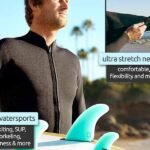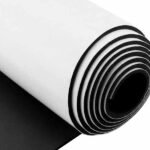Choosing the right wetsuit can make or break your water sports experience. Wearing the wrong wetsuit can lead to discomfort, reduced performance, and even health risks like hypothermia. As someone passionate about surfing and diving, I’ve faced these challenges firsthand. Finding the perfect wetsuit that matches the water temperature is essential for both safety and enjoyment.
Selecting the appropriate wetsuit based on water temperature ensures maximum comfort, performance, and protection during your aquatic activities.
I recall a chilly morning when I went surfing without the right wetsuit. The cold water was unbearable, and I struggled to stay warm and focused. This experience drove me to understand how different wetsuits perform in various temperatures. In this guide, I’ll share everything you need to know about choosing the right wetsuit for different water temperatures.
What temperature should I wear a wetsuit at?
Determining the right temperature for wearing a wetsuit is the first step in ensuring a comfortable and safe water sports experience. Knowing when to wear a wetsuit helps you maintain body warmth and protect against cold water conditions.
Wetsuits are essential when water temperatures drop below 60°F (15°C), providing necessary insulation and protection for extended periods in cold water.
Imagine diving into water that’s too cold without proper insulation. The immediate shock can lead to muscle cramps and decreased performance. Understanding the temperature ranges and corresponding wetsuit types can prevent such discomfort and enhance your overall experience.
Understanding Temperature Ranges
Water Temperature Guidelines
| Water Temperature | Recommended Wetsuit Thickness | Activities Suitable For |
|---|---|---|
| 50-60°F (10-15°C) | 5/4mm Full Suit | Surfing, Diving, Snorkeling |
| 60-70°F (15-21°C) | 3/2mm Full or Spring Suit | Surfing, Windsurfing, Stand-Up Paddle |
| 70-80°F (21-27°C) | 2mm Spring Suit or Shorties | Swimming, Casual Snorkeling, Light Surfing |
| 80°F+ (27°C+) | Rash Guard or Board Shorts | Warm Water Swimming, Stand-Up Paddle |
How Do Different Water Temperatures Affect Wetsuit Choice?
Different water temperatures require different wetsuit materials and thicknesses to provide adequate insulation and flexibility. The right wetsuit enhances performance and comfort by adapting to the thermal conditions of the water.
Choosing a wetsuit based on water temperature ensures optimal insulation and flexibility, enhancing your performance and comfort in the water.
When water temperatures vary, so do the demands on your wetsuit. Let’s explore how each temperature range influences the type of wetsuit you should choose.
Factors Influencing Wetsuit Choice
Insulation Needs
Cold water increases heat loss from the body, necessitating thicker wetsuits made from materials like neoprene with higher thermal resistance. In warmer waters, thinner wetsuits or rash guards suffice as heat retention is less of a concern.
Flexibility and Mobility
Thicker wetsuits provide more insulation but can restrict movement. Balancing thickness with flexibility is crucial for activities that require a full range of motion, such as surfing or diving.
Which Wetsuit Thickness Is Best for Specific Temperature Ranges?
The thickness of a wetsuit plays a critical role in determining its suitability for different water temperatures. Thicker wetsuits offer more insulation, while thinner ones provide greater flexibility and comfort in warmer conditions.
Selecting the appropriate wetsuit thickness based on water temperature enhances warmth and flexibility, ensuring a comfortable and effective performance in the water.
Recommended Thickness for Various Temperatures
| Temperature Range | Wetsuit Thickness | Benefits |
|---|---|---|
| 50-60°F (10-15°C) | 5/4mm Full Suit | Maximum insulation, suitable for cold water activities |
| 60-70°F (15-21°C) | 3/2mm Full Suit | Balanced warmth and flexibility for moderate conditions |
| 70-80°F (21-27°C) | 2mm Spring Suit | Light insulation, high flexibility for warmer waters |
| 80°F+ (27°C+) | Rash Guard | Minimal insulation, optimal for hot water |
Choosing the Right Thickness
Cold Water Activities
For activities like surfing or diving in cold waters (50-60°F), a 5/4mm full suit is ideal. The extra thickness provides the necessary insulation to keep you warm during prolonged exposure to cold temperatures.
Moderate Water Activities
In water temperatures ranging from 60-70°F, a 3/2mm full or spring suit offers a good balance between warmth and mobility. This thickness is suitable for a variety of water sports, providing enough insulation without compromising flexibility.
Warm Water Activities
For warmer water conditions (70-80°F), a 2mm spring suit or shorties are recommended. These wetsuits provide light insulation while allowing for greater movement and comfort during extended periods in the water.
Hot Water Activities
In hot water (80°F+), a rash guard or board shorts are sufficient. These minimal garments offer protection against the sun and abrasions while keeping you cool and comfortable.
What Are the Different Types of Wetsuits and Their Suitable Temperature Ranges?
Wetsuits come in various types, each designed to cater to specific water temperature ranges and activities. Understanding the different types helps in selecting the most suitable wetsuit for your needs.
Different types of wetsuits are designed to provide optimal insulation and flexibility for specific temperature ranges and water activities, enhancing both comfort and performance.
Types of Wetsuits
Full Wetsuit
A full wetsuit covers the entire body from neck to ankles, providing maximum insulation and protection. Ideal for colder water temperatures, it retains body heat effectively, making it suitable for activities like surfing and diving in cold conditions.
Spring Suit
A spring suit offers a balance between coverage and flexibility. It typically covers the torso and legs while leaving the arms exposed. Suitable for moderate water temperatures, it provides adequate warmth without restricting arm movement, making it perfect for surfing and other water sports.
Shorty Wetsuit
Shorty wetsuits have short sleeves and legs, offering minimal coverage. They are ideal for warmer water temperatures, providing light insulation while allowing for maximum mobility. Perfect for casual swimming and light water activities in warm climates.
Rash Guard
Rash guards are lightweight, sleeveless tops that protect against sunburn and abrasions. They are not designed for insulation but are ideal for hot water conditions. Suitable for activities like snorkeling and surfing in warm waters.
Choosing the Right Type
Activity-Specific Choices
Different water activities require different wetsuit types. For instance, full wetsuits are essential for diving in cold waters, while rash guards are perfect for snorkeling in tropical climates.
Temperature Compatibility
Ensure that the wetsuit type aligns with the water temperature. Full suits for cold, spring suits for moderate, and shorties or rash guards for warm to hot conditions.
How Do Features Like Seams, Zippers, and Linings Affect Wetsuit Performance in Different Temperatures?
The construction features of a wetsuit, such as seams, zippers, and linings, significantly impact its performance and suitability for various water temperatures. These elements determine the wetsuit’s insulation, flexibility, and overall durability.
Seam construction, zipper quality, and lining materials are critical factors that influence the effectiveness and comfort of wetsuits in different temperature conditions.
Key Features and Their Impact
Seam Types
| Seam Type | Insulation Efficiency | Flexibility | Durability |
|---|---|---|---|
| Blind Stitch | High | Moderate | High |
| Glued and Blind | Very High | High | Very High |
| Flatlock | Low | High | Moderate |
| Sealed Seams | Extremely High | Moderate | Very High |
Blind Stitch Seams
Blind stitch seams are sealed on the inside to prevent water from entering. They offer high insulation efficiency, making them suitable for colder temperatures. While they provide good durability, they offer moderate flexibility, which is ideal for activities requiring a balance of warmth and movement.
Glued and Blind Seams
Glued and blind seams provide the highest level of insulation and durability. The additional glue ensures that water cannot penetrate the seams, making them perfect for very cold water conditions. These seams are highly durable but offer only moderate flexibility.
Flatlock Seams
Flatlock seams are stitched without sealing, allowing some water ingress. They are highly flexible and comfortable, making them suitable for warmer water temperatures where insulation is less critical. However, they offer lower insulation efficiency and moderate durability.
Sealed Seams
Sealed seams use tape or adhesive to cover all stitching lines, providing extreme insulation and preventing water from entering. These seams are ideal for the coldest water conditions and offer very high durability, though they may slightly reduce flexibility.
Zipper Quality
| Zipper Type | Water Resistance | Ease of Use | Durability |
|---|---|---|---|
| Standard | Low | Easy | Moderate |
| Waterproof | High | Moderate | High |
| Internal | Very High | Difficult | Very High |
Standard Zippers
Standard zippers are easy to use but offer low water resistance. They are best suited for warmer temperatures where minimal water ingress is acceptable.
Waterproof Zippers
Waterproof zippers provide high water resistance, making them suitable for colder water conditions. They prevent water from entering the wetsuit, enhancing insulation and durability.
Internal Zippers
Internal zippers are concealed inside the wetsuit, offering very high water resistance and durability. They are ideal for the coldest water temperatures but can be more challenging to use.
Linings
| Lining Type | Insulation | Comfort | Moisture Wicking |
|---|---|---|---|
| Neoprene | High | Moderate | Low |
| Fleece | Very High | High | Moderate |
| Polyester Mesh | Low | High | High |
| Thermal Linings | High | Moderate | Low |
Neoprene Linings
Neoprene linings provide excellent insulation, enhancing the wetsuit’s ability to retain body heat. They offer moderate comfort but have low moisture-wicking properties, which can lead to sweat accumulation.
Fleece Linings
Fleece linings offer very high insulation and excellent comfort. They help keep the body warm and dry by trapping heat and wicking away moisture moderately.
Polyester Mesh Linings
Polyester mesh linings are highly breathable and excellent at wicking moisture. While they provide lower insulation, they enhance comfort by allowing better airflow and reducing sweat buildup.
Thermal Linings
Thermal linings provide high insulation and moderate comfort. They are designed to maximize heat retention while maintaining some moisture-wicking capabilities.
Do Fit and Sizing Influence the Effectiveness of a Wetsuit in Different Temperatures?
A wetsuit’s fit and sizing are crucial factors that determine its effectiveness and comfort. An ill-fitting wetsuit can lead to water ingress, reduced insulation, and restricted movement, impacting performance and safety.
Proper fit and accurate sizing ensure that the wetsuit provides optimal compression, insulation, and flexibility, enhancing its performance in various temperature conditions.
Importance of a Proper Fit
Compression and Insulation
A well-fitted wetsuit provides the right amount of compression, which helps in maintaining body heat and improving blood circulation. Tight-fitting wetsuits reduce water movement between the suit and the skin, enhancing insulation and preventing chills in cold water.
Mobility and Comfort
A correctly sized wetsuit allows for a full range of motion, essential for activities like surfing, diving, and swimming. It ensures that the wetsuit moves with your body without causing discomfort or restricting movement.
Sizing Guidelines
| Body Measurement | Wetsuit Size Recommendation |
|---|---|
| Chest | 1 inch below the bust |
| Waist | 1 inch above the waist |
| Hips | 1 inch below the hips |
| Height | Adjust based on manufacturer’s chart |
Measuring Yourself
Accurate body measurements are essential for selecting the right wetsuit size. Measure your chest, waist, hips, and height, and refer to the manufacturer’s sizing chart to find the best fit. Wearing a wetsuit that is too tight can cause discomfort and restrict movement, while one that is too loose can allow water ingress, reducing insulation.
Trying Before Buying
If possible, try on the wetsuit before purchasing. Ensure that it fits snugly without being overly tight, and that you can move freely without feeling restricted. Pay attention to areas like the shoulders, elbows, and knees, where flexibility is crucial.
Conclusion
Choosing the right wetsuit based on water temperature is essential for a comfortable and effective water sports experience. Whether you opt for neoprene or latex, understanding the differences in materials, thickness, features, and fit can help you make an informed decision that aligns with your fitness goals and comfort preferences.
At Szoneier, we specialize in high-quality wetsuits tailored to meet your specific needs. With our 20 advanced production lines, we ensure that each wetsuit is crafted with precision and meets strict quality standards. Our products are trusted by athletes and enthusiasts in Europe, North America, and Australia for their superior performance and durability.
Choosing Szoneier means you will benefit from:
- Premium Materials: We use top-grade neoprene and latex to ensure our wetsuits provide optimal insulation and flexibility.
- Customizable Options: Customize colors, patterns, thickness, and features to match your specific requirements and brand identity.
- Flexible Sizing: Our wetsuits are available in a wide range of sizes to ensure a perfect fit for every body type.
- Competitive Pricing: We offer high-quality wetsuits at competitive prices, making it easier for brands to provide excellent products without breaking the bank.
- Responsive Support: Our dedicated team provides timely communication and support throughout the customization and production process, ensuring your orders are handled smoothly and efficiently.
If you’re looking to enhance your brand with top-quality wetsuits, contact us today for free samples and personalized consultations. Let’s work together to create wetsuits that not only meet but exceed your expectations!











